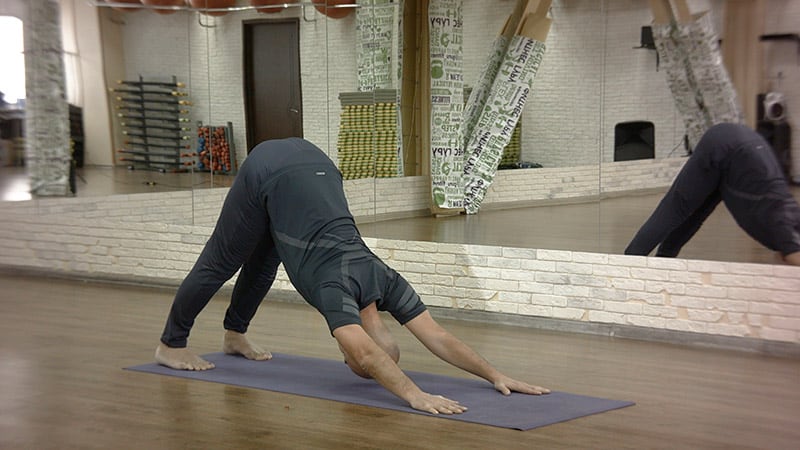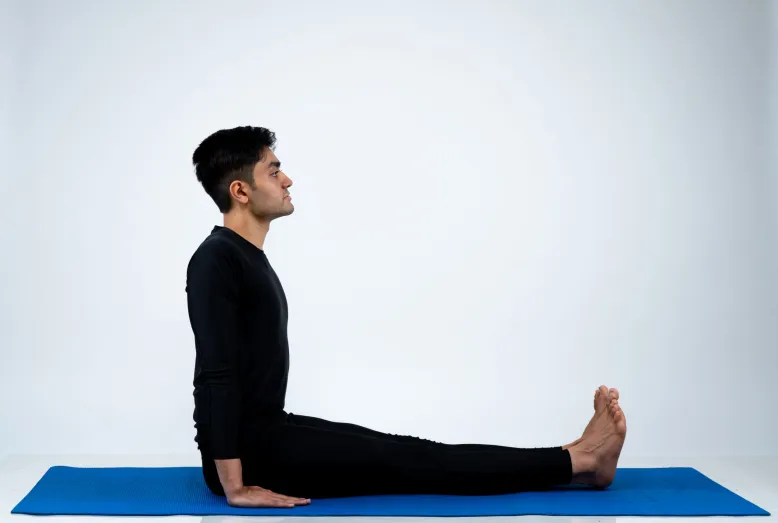In the enormous ocean of yoga asanas, one stance stands out for its pervasive presence and deep benefits: Adho Mukha Svanasana, also known as the Downward-Facing Dog stance.
This stance, based on the ancient practice of yoga, is acclaimed for its capacity to energize the body, soothe the mind, and establish a profound connection between breath and movement.
As practitioners unfold their bodies into this iconic pose, they start on a journey of self-discovery, balance, and refreshment. In this article, we’ll look at the history, practices, and advantages of Adho Mukha Svanasana, as well as the tremendous influence it may have on one’s physical, mental, and spiritual health.
Origins and Philosophy:
Adho Mukha Svanasana has its roots firmly embedded in the rich fabric of yoga philosophy and practice. The Sanskrit word ‘Adho Mukha Svanasana’ consists of three parts: ‘Adho’ means downward, ‘Mukha’ means face, and ‘Svanasana’ means dog posture. Symbolically, the pose represents a dog extending itself after a peaceful snooze, exemplifying nature’s elegance and flexibility.
This famous stance is significant beyond its physical expression; it represents surrender, humility, and the willingness to let go of what no longer serves us. In yoga philosophy, the inversion caused by Adho Mukha Svanasana indicates a change in viewpoint—a chance to see the world from a new perspective, both figuratively and physically. By focusing inside and letting go of attachments, we may gain a better understanding of ourselves and the world.
Breath Awareness:
Adho Mukha Svanasana, like all other yoga poses, emphasizes the connection between breath and movement. Conscious breathing not only improves the physical sensation of the posture, but it also relaxes the mind and promotes a feeling of presence and awareness.
Adho Mukha Svanasana allows the breath to flow freely and regularly, in harmony with the body’s ebb and flow. As the practitioner inhales, they stretch the spine, bringing energy and vigor into the body. On the exhale, they sink further into the position, releasing any tension or resistance with each breath. Maintaining this conscious breathing rhythm throughout the practice promotes calm and inner peace, helping practitioners to dig deeper into their practice with each subsequent breath.
Advantages of Adho Mukha Svanasana:
Adho Mukha Svanasana has several advantages, including physical, mental, and emotional well-being. As a basic posture in yoga, it serves as the basis for various sequences and practices, providing practitioners with several benefits that go well beyond the mat.
Strengthens and lengthens muscles.
- Adho Mukha Svanasana is a powerful full-body stretch that works many muscle groups, including the hamstrings, calves, shoulders, and arms.
- The position strengthens the arms, shoulders, and core, promoting stability and posture.
- Regular practice helps reduce spinal stiffness and tension, allowing for increased flexibility and range of motion.
Improves circulation and digestion.
- The inverted position of Adho Mukha Svanasana promotes venous return and blood flow to the brain and heart.
- The moderate compression of the abdomen stimulates the digestive organs, resulting in improved digestion and excretion.
It relieves stress and anxiety.
- Adho Mukha Svanasana is a natural stress reliever that relaxes the mind and soothes frazzled nerves.
- The mild inversion promotes the release of tension in the neck, shoulders, and back, bringing relief from physical symptoms of stress.
Promotes emotional balance and well-being.
- The mild inversion of Adho Mukha Svanasana helps promote emotional balance and inner calm.
- Regular practice promotes introspection and self-awareness, allowing practitioners to face life’s problems with grace and perseverance.
How to Do Adho Mukha Svanasana
- Start on your hands and knees, with your knees directly under your hips and your hands directly under your shoulders.
- Press down into your hands and lift your knees off the floor, straightening your legs behind you.
- Reach your heels down towards the floor, keeping your knees slightly bent.
- Press your hips back and up, lifting your tailbone away from the floor.
- Draw your shoulders away from your ears and down your back.
- Keep your neck long and in line with your spine.
- Breathe deeply and evenly.
- Stay in the pose for 5-10 breaths, or longer if you are comfortable.
- To come out of the pose, bend your knees and lower yourself back down to your hands and knees.
Precautions and modifications:
While Adho Mukha Svanasana has several advantages, it is important to practice the position attentively and with an awareness of personal limits. As with any yoga practice, listening to and acknowledging the body’s messages is critical for avoiding injury and cultivating a safe and sustainable practice.
1. Wrist Sensitivity:
Individuals with wrist injuries or sensitivities may feel difficulty when doing Adho Mukha Svanasana.
To relieve wrist discomfort, practitioners may alter their posture by putting props like yoga blocks or a folded blanket beneath the heels of their hands for support.
2. Hamstring tightness:
Tight hamstrings might prevent the legs from completely extending in Adho Mukha Svanasana, causing lower back discomfort.
To relieve tension and allow for a deeper stretch over time, practitioners might gently bend their knees or lay a yoga block under their heels.
3. Shoulder or neck issues:
Those with shoulder or neck ailments should use care while doing Adho Mukha Svanasana, avoiding undue strain or compression in these regions.
Modifying the position by maintaining a small bend in the elbows or utilizing a broader arm stance might help relieve pain and provide more support.
4. High blood pressure and eye conditions:
Individuals with high blood pressure or certain eye problems, such as glaucoma, should use care while doing inversions like Adho Mukha Svanasana.
You should consult with a competent yoga teacher or a healthcare practitioner to establish appropriate adjustments or alternatives.
Final Thought
Adho Mukha Svanasana exemplifies the transformational power of yoga, providing a path to physical energy, mental clarity, and spiritual awareness. Beyond its outward representation as a stance, this famous position reflects the core of yoga—union and balance.
Which chakra is balanced in Adho Mukha Svanasana?
Adho Mukha Svanasana, or the Downward-Facing Dog Pose, is a pose that influences multiple chakras, with the primary chakra being the Muladhara Chakra or Root Chakra. This pose stimulates the Root Chakra, promoting stability and trust. It also influences the Svadhisthana Chakra, associated with creativity and pleasure, by balancing energy flow. Adho Mukha Svanasana promotes balance and harmony in the energetic system, including the Root and Sacral Chakras.
What are the limitations of adho mukha svanasana?
Limitations of Adho Mukha Svanasana
Wrist Sensitivity or Injury:
• Weight-bearing nature can put pressure on wrists, causing discomfort or exacerbating existing injuries.
• Use props like yoga blocks or modify hand placement to reduce strain.
Shoulder Issues:
• Excessive strain on shoulders can aggravate existing conditions or lead to injury.
• Modify the pose by keeping a slight bend in the elbows, widening the stance of the arms, or practicing gentler variations.
Neck Problems:
• Heavy hanging or sinking into the shoulders can strain the neck and exacerbate pain.
• Keep the neck aligned with the spine and avoid excessive pressure on the cervical spine.
High Blood Pressure or Glaucoma:
• Adho Mukha Svanasana is an inversion, which can temporarily increase blood pressure.
• Consult with a healthcare professional before practicing inversions.
Pregnancy:
• Pregnant individuals may find Adho Mukha Svanasana uncomfortable due to pressure on the abdomen and hormonal changes.
• Practice under the guidance of a qualified prenatal yoga instructor.
Hamstring Tightness:
• Struggle to fully extend legs in Adho Mukha Svanasana can lead to strain in the lower back or hamstrings.
• Bend the knees slightly or use props like yoga blocks to reduce tension.
What are the other names for adho mukha svanasana?
Adho Mukha Svanasana, also known as the Downward-Facing Dog Pose, is a popular yoga posture with various names across different yoga traditions. It is known for its numerous benefits, including strength, flexibility, and inner balance. Variations include Parvatasana, Ardha Adho Mukha Svanasana, Parvat Asana, Triad Asana, and Downward Dog Pose. Despite its diverse names, the pose remains recognizable worldwide, reflecting the rich tapestry of yoga’s history, lineage, and cultural influences.
What are the contraindications for adho mukha svanasana?
Adho Mukha Svanasana, a beneficial yoga pose, has certain contraindications. These include wrist injuries, shoulder injuries, high blood pressure, glaucoma, pregnancy, recent surgery or injury, and vertigo or inner ear issues. Wrist injuries may cause discomfort or exacerbation of symptoms when bearing weight on the hands in Adho Mukha Svanasana. Shoulder injuries may aggravate existing shoulder issues, and inversions may temporarily increase blood pressure. High blood pressure practitioners should consult a healthcare professional before practicing inversions. Glaucoma patients should avoid inversions, as they can further elevate intraocular pressure and increase the risk of vision loss. Pregnant individuals should avoid abdominal compression, and those recovering from recent surgery should avoid Adho Mukha Svanasana until fully healed. Vertigo or inner ear issues should be cautious when practicing inversions.





No Comments